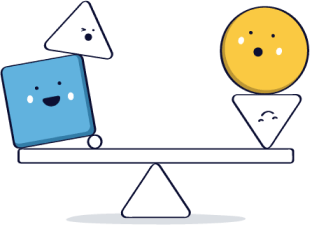Definition of customer success

"Nutshell is super gebruiksvriendelijk en intuïtief

"Ik zou Nutshell

"Gemakkelijk te gebruiken en... wacht erop... 100% koop!

"Nutshell is zowel eenvoudig als krachtig
For your business to succeed long-term, you need to ensure your customers succeed with the help of your products or services. The best way to accomplish this is with a customer success strategy. Keep reading for step-by-step instructions on how to build a customer success strategy.



Volg onze rondleiding en ontdek de ongelofelijke functies van Nutshell!

To truly succeed in business in the long term, you need to do more than just acquire new customers. You need to help your customers solve their problems through your products or services. When you provide value to your customers in this way, you make yourself a crucial part of how they run their businesses or lives. This means they’ll stick around and potentially even refer new customers to you.
In other words, your customers’ success is your success.
More businesses are adopting this mindset, especially as subscription models become more common. Customer success is important to every business, though, so no matter your industry, you need to know how to build a customer success strategy. That’s what we’ll cover in this guide, from the essential elements of customer success to common challenges and solutions to a step-by-step process for building your customer success strategy.
Customer success is a business strategy that helps customers maximize the value they get from your products and services and achieve the outcomes they want from working with your business. The responsibilities involved in customer success vary but include building relationships with customers, providing training on product use, and assisting customers in creating strategies for achieving their goals.
Focusing on customer success leads to many benefits both for your business and your customers. To reliably get to these benefits, you need a smart customer success strategy in place. Some of the key benefits of customer success include:
A customer success strategy helps your customers get more value from your products or services, which in turn causes them to invest more back into your business. This leads to improved outcomes and increased revenue for you and your clients, demonstrating why your customers’ success is your success.
Because customer success improves your customer relationships and your customers’ results, it leads to them sticking with your business longer. It costs from five to 25 times more to acquire new customers than to retain existing ones, so reducing churn through customer success is important for your business’s growth.
In addition to increasing retention, improved customer satisfaction due to customer success can improve your company’s reputation in general. Happier customers can provide reviews, testimonials, better customer satisfaction scores (CSAT), and word-of-mouth referrals, boosting your reputation and growing your customer base.
As your customer success team develops relationships with your customers, they can gather feedback about customers’ experiences with your product. You can use this feedback to enhance your offerings and internal processes to improve customer satisfaction.
With a well-structured customer success strategy in place, processes such as onboarding, renewals, and upsells are more efficient. Proactive customer success can also reduce demand on your support team. This increased efficiency saves you time and money and enhances the customer experience.
Explore how customer expectations are changing, the impact of AI, and how to manage

Ready to start building your customer success strategy? Just follow these steps!
Before you begin creating your new customer success strategy, it’s important to have a solid understanding of your current customer experience.
This involves ensuring you have access to customer data and gathering any available customer feedback. You may want to conduct a survey to collect feedback on customers’ experience with your company.
To get a deeper understanding of your current customer experience, map your customer journey—the sequence of interactions customers have with your brand from first learning about you to becoming a customer and beyond. As you map this journey, include all customer touchpoints or interactions someone has with your brand, including with ads, website content, salespeople, support personnel, and more.
This information will provide insights into what’s working and what you can improve and guide your decisions as you develop your customer success plan.
The first step when building a customer success strategy is to define your vision for the initiative. This vision includes your specific measurable goals for the program as well as the type of culture you want to create—one focused on the customer and their success.
An important part of defining your vision is identifying the moments of value realization you want your customers to experience. These are the moments in which your customers clearly see the value your product or service provides for their business. Your customer success strategy should consistently lead customers to these moments of value realization.
Additionally, set measurable objectives for your customer success program and define the key performance indicators (KPIs) you’ll use to measure your progress. Some examples of metrics to track include:
Now, we’ll get into the nitty-gritty of creating your success processes using the information you gathered and the goals you set in the first two customer success strategy steps.
Your customer data is going to be essential to your customer success strategy, so you want to determine how you’ll manage your data, including what data you’ll track, who will be responsible for tracking it, and the tools you’ll use to store and manage your data.
You’ll want to keep track of basic customer data like contact details, business information, and purchase history. You’ll also want to keep a history of all your team’s interactions with each customer.
A customer relationship management (CRM) platform streamlines this process by automatically tracking this data and ensuring your entire team has access to the same information.
Check out this free guide to find out if a CRM is the right tool for your business.

Segmenting customers into groups based on their characteristics helps you conduct more personalized outreach since different types of customers have different needs. It also enables you to track customer success metrics by segment and adjust your approach for each category of customer.
How you split up your customers depends on your goals. Some common ways to segment customers include by purchase size, by the products they purchased, and by industry.
Customer onboarding is the process of getting new customers set up and acquainted with your products or services.
This process is one of the first customers go through after signing up, so it’s important to get it right to ensure customers can quickly get value from your product and to reduce early churn.
Onboarding should be one of the main focuses of your customer success team, both because it’s important and because this is typically when customers need the most assistance. In fact, 63% of SaaS customers say onboarding is a key factor they consider when deciding whether to subscribe to a new tool.
Some factors to consider when creating your onboarding plan include:
An important part of customer success is regularly engaging with your customers. When devising your plan, decide how often you’ll reach out and what methods you’ll use to do so.
For example, you might have customer success managers reach out at regular intervals by email, especially to high-value customers, just to check in on how they’re doing and see if they need any process. Using a CRM with personal email sequences, you can automate this outreach while still allowing team members to send personal replies when customers respond.
Your customer success team might also reach out to share important product updates or share new resources.
This proactive outreach helps to keep customers engaged and solve problems before they impact customer satisfaction.
Customer success can have a significant impact on retention. Everything you do throughout the customer success process helps to reduce churn, but it’s also useful to pay specific attention to it when creating your customer success strategy framework.
One area to consider is renewals. It’s helpful to automate as much of the renewal process as possible and monitor renewals closely. For instance, if a customer’s payment method fails, you can send them an alert and nudge them to update it.
In addition to your standard proactive reach, you should also watch for at-risk customers so that you can help them address any issues they’re having and prevent them from churning. You can accomplish this by monitoring metrics like health score, product adoption rate, and CSAT.
Another responsibility of customer success, sometimes in conjunction with the sales team, is upselling and cross-selling.
Upselling is selling a customer an upgraded, higher-value version of the item they’ve already purchased or are already interested in, such as a higher tier of a software subscription. Cross-selling refers to selling a customer another product or service that’s related to but separate from what they’ve already purchased.
The likelihood of selling to an existing customer is 60-70% compared to 5-20% for a new prospect, according to the book Marketing Metrics, so upselling and cross-selling are significant opportunities for businesses.
From the customer success perspective, though, you don’t want to think of cross-selling and upselling as merely trying to get more revenue from a customer. Instead, you can think of it as offering them additional value based on their needs.
As customer success managers get to know their customers, they’ll be able to identify opportunities for them to get more value from your product, which sometimes involves upgrading or adding complementary features.
Although you never want to have to offboard your customers, it’s important to have a strategic process in place for when a customer wants to cancel their account or stop using your services.
With a solid offboarding plan, you have one last chance to prevent a customer from churning. Even if they don’t change their mind immediately, leaving a good impression during offboarding might encourage them to come back at a later date.
Even if a customer does churn, you can use the opportunity to gather information to improve your product and customer experience.
To optimize your offboarding, make sure the process is easy for the customer and support them throughout the entire process. When a customer does leave, send out a feedback form to learn why they canceled, what they liked about their experience, and what you may be able to improve.
Another essential element of a customer success strategy is clearly designating roles and responsibilities.
This includes defining what areas customer success is responsible for and what the roles of sales, marketing, support, and other departments are. Clearly defining these responsibilities prevents confusion and keeps your customer journey running smoothly.
Along with this, you’ll also need to define roles within your customer success team. This typically includes assigning customers to team members and ensuring everyone knows what tasks they’re expected to complete and the role they play in achieving your business’s objectives.
Your customer success team makes sure your customers have what they need to succeed, so make sure you set your customer success team up for success too.
A key part of this is technology. As you create your customer success strategy, determine what technology you need to achieve your goals and make your processes more efficient through automation and improved organization. Some common tools used in customer success include:
Another essential resource for customer success teams is internal documentation. It’s important to document your processes and best practices and ensure your team has easy access to resources. It’s also important that your team can easily access customer-facing resources like onboarding guides and support articles.
To help your team make the most of these tools and resources, training is vital. Before you launch your new strategy, provide training and give your team a chance to get used to new processes and tools. As teams learn the new systems, answer questions and gather feedback you can use to improve your strategy.

Woon een live rondleiding bij!

Once you’ve created your plan, set up your technology, and trained your team, it’s time to launch your new customer success strategy.
As you roll out your strategy, watch for potential inefficiencies and challenges your team is having. It’s completely normal for there to be an adjustment period and to need to make a few tweaks early on.
Monitoring your program doesn’t stop in the early stages, though. It’s a continual process. Make sure you track and report on your customer success metrics and use these reports along with feedback from your customers and team to continually optimize your strategy.
For your business to succeed, you need your customers to succeed. And the best way to ensure that happens is with a well-designed customer success strategy. Use this guide to create yours, and you’ll have a win-win situation for you and your customers.
In addition to a solid strategy, you also need the right tools. Nutshell can help you streamline your customer success management with features like:
To see for yourself how Nutshell can help you manage your customer success strategy and grow your business, start a free 14-day trial today.
Probeer Nutshell 14 dagen gratis uit of laat ons je rondleiden voordat je erin duikt.

Inhoudsopgave

Sluit je aan bij 30.000+ andere verkoop- en marketingprofessionals. Schrijf je in voor onze Sell to Win nieuwsbrief!
 Synchronisatie van e-mail en agenda
Synchronisatie van e-mail en agenda
Use our calculator to add up your total investment of CRM and Add-ons
VIEW ALL PRICING
 Product Info
Product Info Onderwijs & gidsen
Onderwijs & gidsen Bedrijf
Bedrijf